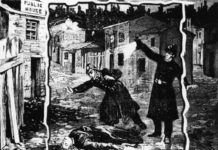Air Conditioning – The King of Cool
Nobody is sure of the exact date of the beginning of mankind. Many historians estimate that the first evidence of controlled fire can be dated to one million years ago whilst others point to the evidence of cooked food as far back at 1.9 million years ago.
One thing we can all assume is that humans could not have evolved without fire and so the two are irrevocably connected.
And it is fire that has been used to enable humans to live in cold climates from the dawning of the species until now although, admittedly, it is not the only option these days.
Two thousand years ago the Romans, who had already mastered the art under floor heating, made attempts at cooling a room by circulating cold water from aqueducts around their buildings.
A few centuries later the Chinese invented the rotary fan which was to remain the most effective way of keeping people cool for the next one thousand seven hundred years.
Efforts were made to make the long summers living in the new big American Cities more comfortable and in 1758 Benjamin Franklin and John Hadley, a Cambridge University professor, experimented with the liquid evaporation of alcohol and other volatile liquids that were found to cool an object down far enough to be able to freeze water.
But, up until the late 1800’s, the idea of having complete control of the environment inside a building was as ridiculous as was the idea of halting the rain or preventing the sun from shining.
However, in 1901 Willis Carrier, a young electrical engineering student graduated from Cornell University and was offered a position at the Buffalo Forge Company in Buffalo, New York who specialized in making electric fans.
His first assignment was with the Sackett & Williams Publishing Company of Brooklyn, New York who were responsible for producing America’s most popular full colour magazine at that time called Judge Magazine.
But in the heat of July, 1902, Sackett & Williams had a big problem. Because of the humidity levels in their buildings the new colour ink they were using for the front covers would not stick to the page and was simply sliding off.
Carrier was tasked with finding a way of reducing the temperature and humidity in the printing room to precisely 53 degrees as quickly as possible or the publisher faced the reality of failing to produce their monthly issue, at a cost of millions.
Carrier worked night and day on the problem and early one morning, after a few weeks had passed, he was standing on the platform of a foggy railway station when he made his life changing breakthrough.
The engineer knew that fog was simply air that was saturated with water and realised that if he could create 100% humidity in a room he would then be able to introduce enough dry air to then reduce humidity by precise levels. He would be able to reproduce whatever level of humidity he needed.
That day was the 17th July and Carrier faced a race against time if the deadline for the August edition was to be successfully met and immediately began to work on his theory.
He already understood how to heat objects with steam by passing air through hot coils and his simple plan was to reverse the process by pumping air through coils that were cooled down by water.
With the use of his fans he found that he was able to control the temperature, humidity, air circulation and ventilation.
The low heat and humidity he immediately achieved in the print room helped the paper to remain consistent, enabled perfect ink alignment and the American public was not to be deprived of its favourite magazine the following month.
By 1907 Carrier had improved his design and introduced what would later be called by air conditioning engineers as the Law of Constant Dew-Point Depression and applied for a patent on the 17th May which would eventually be issued on February 3rd 1914.
However, war in Europe led to manufacturing companies concentrating their efforts in other areas so Carrier decided to leave the Buffalo Forge Company and with six other young engineers formed the Carrier Engineering Company of New York.
Demand for their air conditioning units remained steady although it wasn’t until 1925 when they designed an air conditioning system for the Rivoli Theatre on Broadway that the general public would be introduced to controlled indoor environments for the first time.
Such was its success that the Rivoli found itself packed to the rafters at all times of day or night as New Yorkers sought relief from the steaming city summer, whatever movie it was they were showing.
Sadly the Stock Market Crash of 1929 and the Great Depression that followed slowed the company’s progress although by 1937 they had still become the largest employer in central New York.
But it would be during the post war economic boom of the late 1940’s and 1950’s that Carrier’s invention began to revolutionise America.
Cinemas, restaurants, factories, schools, hospitals, public buildings, shopping malls and any developing city in the Mid West, West or the Deep South were installing Carriers air conditioning units as fast as they could be produced.
Millions of east-coasters were now prepared to move to the previously inhospitable west and south of America thanks to the new air conditioned environments and both economic and political power shifted with them.
Where the East Coast communities once dominated the American way of life now cities such as Dallas, Phoenix, Atlanta, Miami, Los Angeles grew into the country’s most powerful whilst only New York, Chicago and Philadelphia remain among America’s largest ten from the old East Coast guard. All thanks to the air-conditioning unit.
Throughout his life Carrier received many awards and accolades for his invention that changed the way mankind exists.
Can you imagine, today, surviving in some of the climates of South East Asia, or Africa, if a 25-year-old engineer had not been tasked with reducing the humidity in the printing room of a New York publisher.
And he had not had that moment of inspiration on a foggy New York platform that proved to the scientific community of the time that something generally considered to be impossible (controlling an indoor environment) was, in the end, easily achievable.
Willis Haviland Carrier died a wealthy man in 1950 and the company bearing his name lives on with annual sales in excess of $15 billion and providing over 45,000 people with useful, and comfortable, employment. – Albert Jack
Albert Jack AUDIOBOOKS available for download here
More Awesome Inventions with Albert Jack






































